I’ve long been curious about the islands of Cape Verde. A friend asked me to set up a food self-sufficiency project on the island of Maio, the poorest of the Cape Verde islands, where there has been no rain for 11 years. The small gardens have gradually stopped producing food, and the fruit and vegetable growers have found themselves with their wells running dry and unable – for the first time in a very long time – to plant to meet the needs of the population. The war in Ukraine, with its attendant rise in the price of basic foodstuffs, has exacerbated the food situation, since the island is dependent on the outside world.
The island of Maio
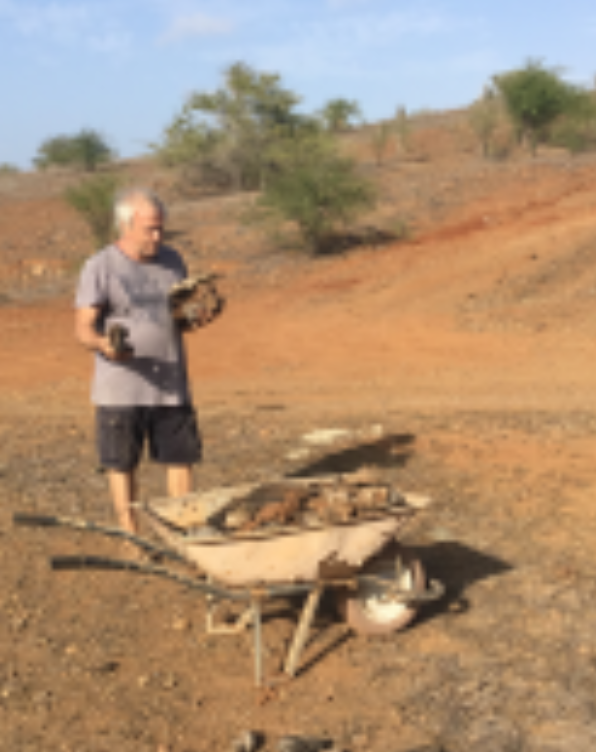
Maio has always been a poor island, and its economic dependence is a major vulnerability. The main economic resources come from fishing and salt production. The other key issue is to move towards “self-sufficiency in food”. Like its colonial past, Cape Verde is now the target of external intervention aimed at radically transforming its food and agriculture. The new Western networks are imposing industrial farming projects, excluding the local know-how of small farmers and family gardeners. Women are often responsible for the survivaĺ of these structures. The ambition of politicians and rich countries is to keep Cape Verde food-dependent by donating poor-quality food in exchange for their voice at the UN and future plans for military bases in the middle of the Atlantic. From my first visit to the island, I appreciated the ‘agricultural’ aspect of this area, the only attempt at reforestation with free-range cows, pigs and goats. But the lack of water blocked any plans.
The heart of the project Forming the lasagne layers
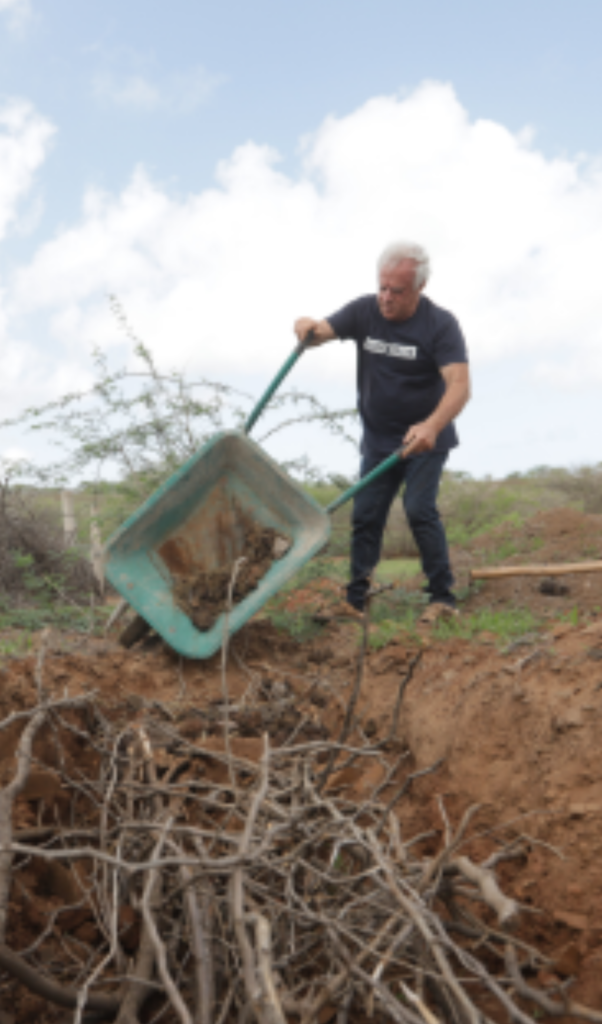
Water, like soil and plants, can be cultivated. Understanding these interrelationships and taking care of them means taking care of life itself. More than half the precipitation on the continents comes from evapo-transpiration from plants and soil. Fresh water from underground aquifers and springs (0.3% of our planet’s water) is the only water that can be used by humans and the earth’s flora and fauna, so it is extremely rare and precious. In Maio, water management remains an absolute priority. The scarcity of water resources is a major problem, and rainfall is falling, bearing in mind that 80% of water resources come from rainfall, which recharges the water tables. Existing agriculture is dying, and many inhabitants receive their water by lorry or buy it by the litre from state-run desalination plants. The foundation of this project will be built first and foremost on water resources, without which nothing is possible. This preciousness brings us back in touch with the sacred dimension of water. Managing water resources in a desert requires a set of technical strategies and a rethinking of established knowledge, in order to realise that elements such as air and soil are living organisms.Our approach to water resources is unique. It’s not a question of doing what is often done, digging a well (here at great depth), installing a pump at great expense and then exploiting this resource without counting the cost, only to find ourselves with brackish water or very little water after a few years.
1 WORKING THE SOIL
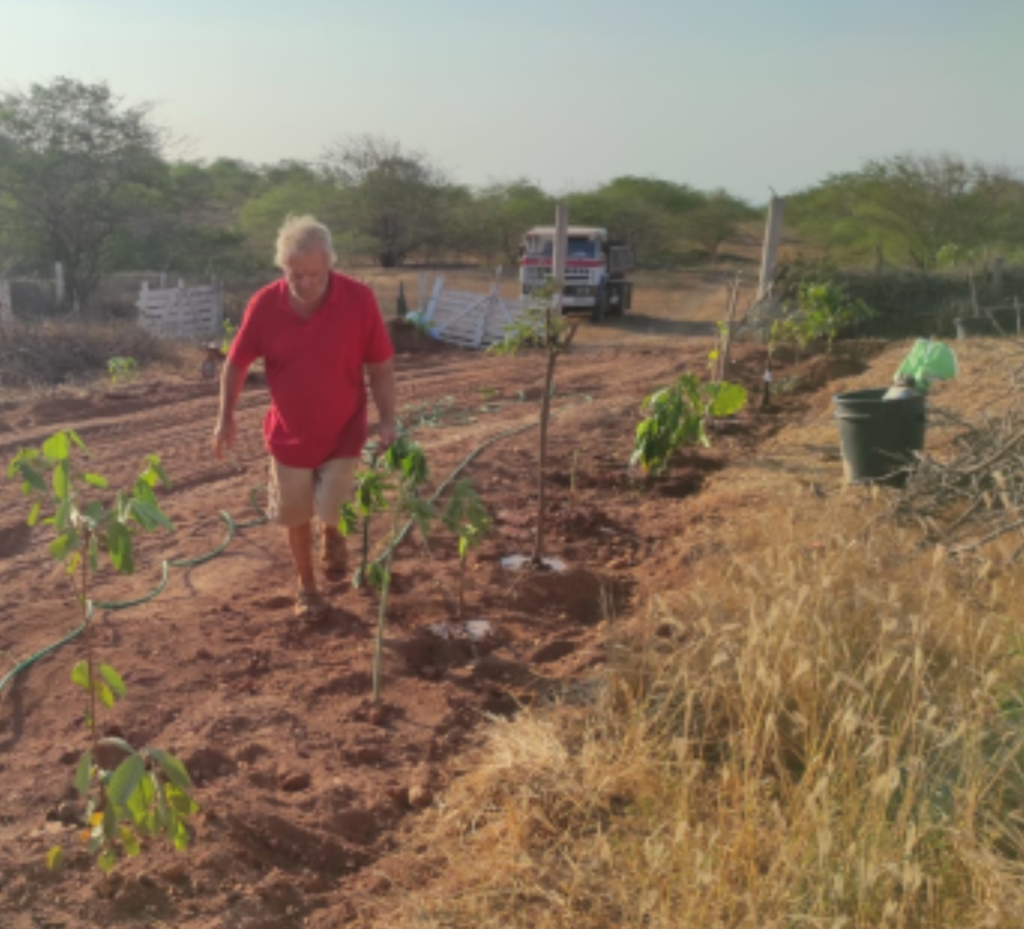
For soil to retain water, it must be alive and contain organic matter. The first phase of the work consists of tending the soil.Specific work following the principles of permaculture is needed to save water.
– The first step is to plant green manure crops such as cowpeas and mucina, which thrive in dry soil.
– Aerate the soil with woody compost to prevent compaction. Organic matter is in fact carbon, and a healthy soil can both retain more water and sequester more carbon. It acts like a sponge: some of the water remains stored and is gradually redistributed. Studies show that adding one tonne of organic matter per hectare increases the water available by 17,000 litres per hectare
– Plant hedges of guiera, a medicinal plant with many virtues, capable of providing moisture. This plant absorbs water during the night and excretes it through its roots to give to neighbouring trees and vegetables (what resilience!).
– Compost animal droppings to enrich the soil. Animal droppings dry out in the sun without being picked up. There are no leaves here, the only trees are thorny acacias, so you can grind up a few dead branches, collect large dry grasses and any decomposing vegetatio
– Introduce mound cultivation, with branch anchors to prevent erosion and improve fertility.Make sure that the soil is sufficiently alive for mycorrhization to take place, using fungi and micro-organisms to nourish and hydrate the roots. As a reminder, the soil is a living organism that creates multiple openings, populated by millions of bacteria, micro-organisms and roots, which allow water to reach the parent rock. In the same way, groundwater can also rise to the surface.
On my farm in France, I was able to revitalise my soil with biochar (a special type of charcoal used by the Terra Préta Amerindians). This biochar lightens the soil, its porosity retains water and provides a home for the micro-organisms, bacteria and yeasts that we give it. Soil needs to be protected by plant cover, so that water can be brought up from the deep layers of the soil. Our concept comes close to creating a multi-storey tropical forest.
The simultaneous presence of annual plants with superficial roots, shrubs with slightly deeper roots and trees with deep roots will enable all the soil profiles to be explored.
The greater evapotranspiration capacity of trees creates a microclimate. A hedge of trees will prevent the soil from drying out by protecting it from the wind. The fact that they are rooted in the soil will allow the soil to absorb water, which will be reinforced by the presence of mycorrhizae. In addition, the differences in height between vegetation layers will allow for condensation by creating temperature differences.
So, where possible, we’re going to plant staggered crops, combining trees, shrubs and vegetables, or combine vegetables like the Milpa: maize and beans, which provide nitrogen for the maize, which acts as a support for the maize, and the squash, which covers the soil and retains moisture. It’s a question of reconciling ourselves with the natural world around us, of being part of this intelligent system that serves life. One of the keys to this project is to integrate into this vision of agroforestry trees that will create biomass, such as moringa, acacia and banana. Pruning these prolific trees will provide vegetation to cover and nourish the soil. Pruning will increase root activity and metabolism, producing gibberellic acid in the soil to stimulate growth.
2 – IRRIGATION
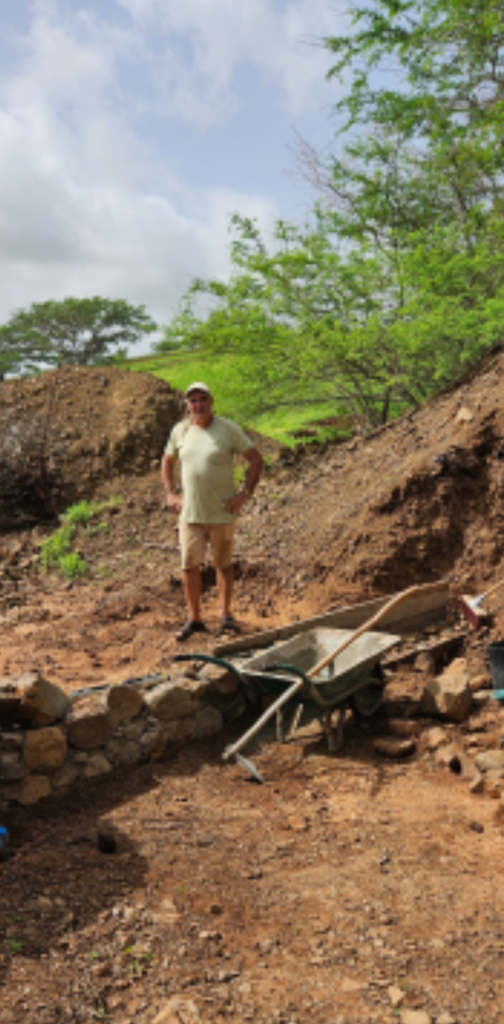
Ancestral techniques have always existed in arid zones :
Gravity irrigation, alternating partial irrigation, potential evapotranspiration, oyas or other buried pots, foggaras, draining galleries in the Sahara, djésours in the deserts of Tunisia and Morocco, fog nets such as the Waka tower, spiral fog towers, trees called fountain trees are also capable of capturing fog, such as the garoé, the fourcroyas (agave) which provide up to 20l of water per day. Channel run-off water through mini-trenches following the topography of the site.
Scientific discoveries are also leading to solutions for water resources: combining modern technology such as atmospheric water generators, magnetic fountains, porous metal-organic materials, water-retention devices such as polyter, hydrogels, low-tech autonomous mini-desalination plants, etc.
3 – NURTURING BIODIVERSITY
A conservatory of endemic tropical food trees corresponding to the island’s biotope:
Coconut, papaya, mango, annona, cherimoya, passion fruit, baobab, dragon fruit, passionflower, banana, tamarisk, citrus, pineapple, etc.
A conservatory of tropical trees from neighbouring countries :
– Annona reticula/ox heart, artocarpus heterophyllus/jacquier, Diospyros digyna/black sapote, acerola, poutéria champechiana/canistel, dimocarpus longan/longani, coffea/coffee tree, Jaltomata cajacayensis, Artocarpusaltilis/bread tree, macadamia…
A conservatory of tropical trees with medicinal properties :
Most tropical fruits have interesting nutritional and medicinal qualities, and the aim here is to select those with the greatest health benefits.
– Euterpe oleracea/Açaï: Typical Amazonian palm, very powerful antioxidant, general tonic, fights cell ageing, very rich in trace elements, stimulates the body’s various functions.
– Annona muriatica: soursop: diuretic, liver detoxifier, regulates blood sugar levels, soothes depression and sleep disorders, fights malaria, leaves are used in anti-cancer protocols.
orinda citrifolia / nonni: Used since time immemorial as an anti-inflammatory, liver detoxifier, regulates blood sugar levels, soothes depression and sleep disorders, fights malaria, and the leaves are used in anti-cancer protocols.
– Morinda citrifolia / nonni: Used since the dawn of time as an anti-inflammatory, anti-bacterial, painkiller, anti-diabetes, blood pressure and sleep regulator, it is a tonic for the body and its active principle: Xeronine is a tumour anti-proliferative. Used externally, it heals wounds and has cosmetic qualities.
– Adansonia digitata/ Baobab, known as the “tree of life” and its fruit as monkey bread. It contains 3 times more calcium than milk. It contains 6 times more potassium than bananas and 6 times more antioxidants than blackcurrants. Very rich in iron and minerals, it is a general tonic, anti-inflammatory, anti-microbial, anti-diarrhoeal and detoxifying. With its 50% fibre content, it regulates transit, is an aphrodisiac, combats skin ageing and promotes healing and skin hydration. African pharmacopoeia uses the bark, leaves, pulp and seeds.
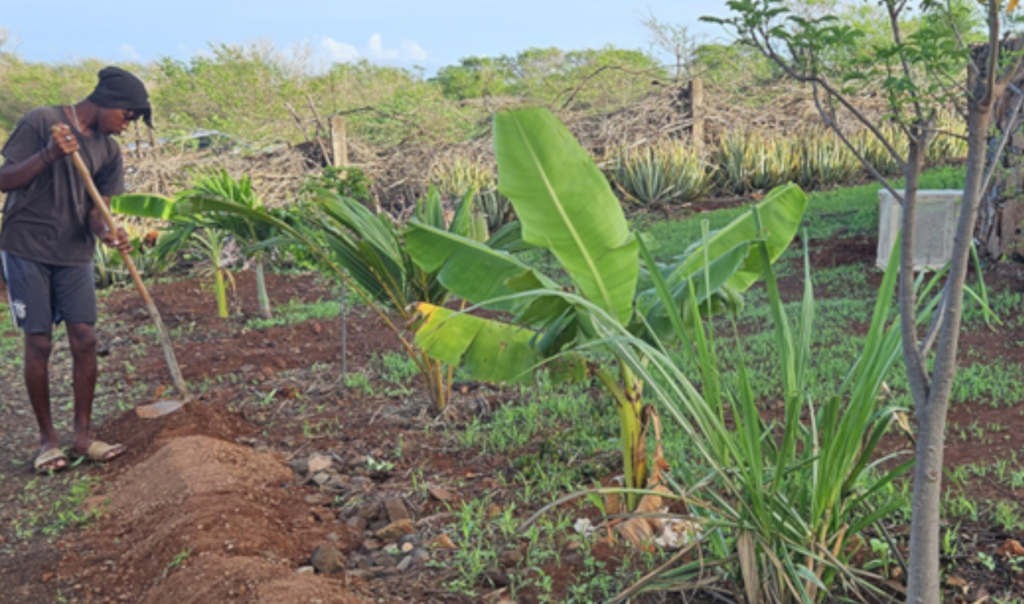
A conservatory of ancient vegetables :
Portuguese heritage with tomatoes, peppers, aubergines, dried beans, broad beans, maize and chillies. African crops include manioc, yams, plantains, sweet potatoes, okra and niebo. Varietal biodiversity is poor, and this is reflected in Cape Verdean cuisine, particularly in Maio.
A conservatory of traditional medicinal plants :
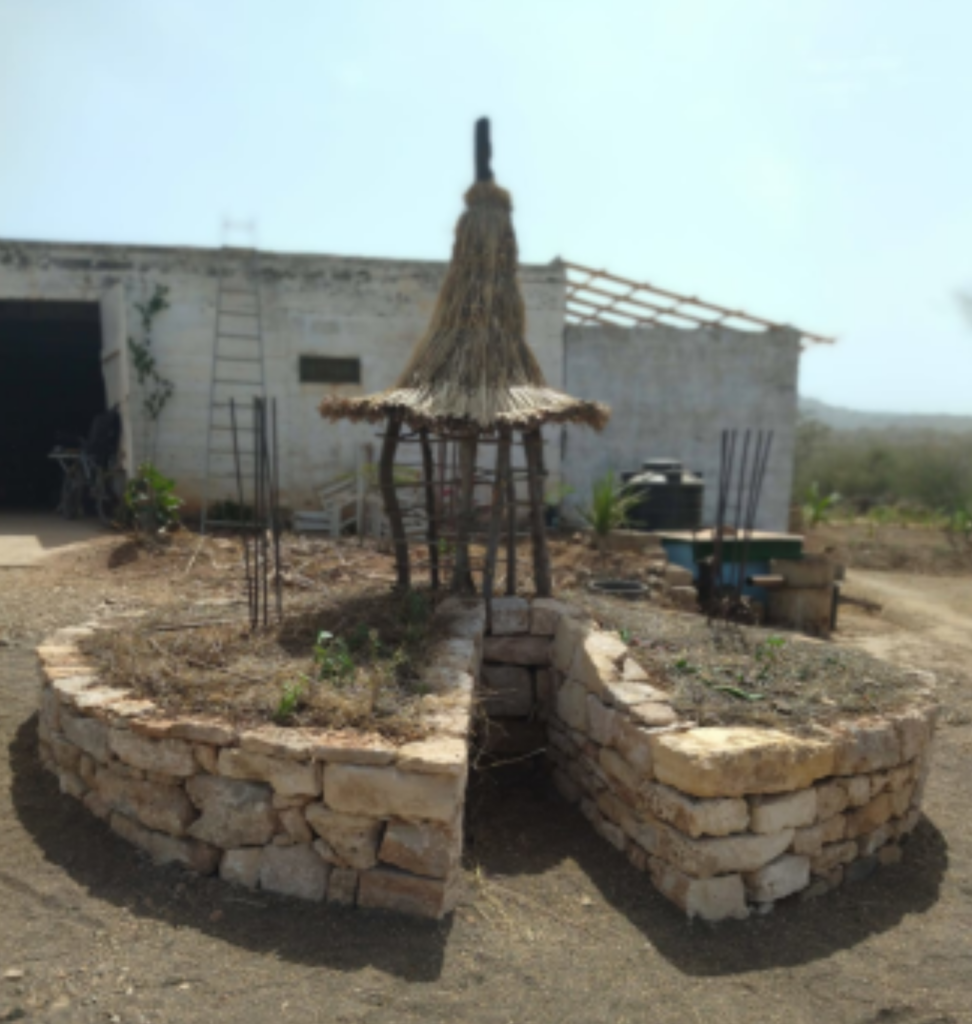
Another problem is that medicinal plants are rare and less and less known, certainly in connection with the slow disappearance of traditional practitioners. In some islands, there are sellers of dried medicinal plants, but they come from Africa or Portugal. There is a lot of work to be done in terms of inventorying local resources.
– Ourinzeira: to combat fevers and the evil eye, planted in front of houses.
– Kalanchoe pimata: anti-inflammatory, healing.
– Artemisia Gorgonum or losma, endemic to Cape Verde: effective against flu and bronchitis. Anti-malarial, anti-viral, anti-tumour.
A research and applications centre to make the most of plants from conservatories or the wild: to produce medicinal and cosmetic products. Reproducing the biodiversity of these conservatories is essential for gardeners, farmers and enthusiasts. The only existing nursery on the island, in Calheta, is now bankrupt. Jobs need to be created to once again produce the trees and plants that are so precious for feeding the population.
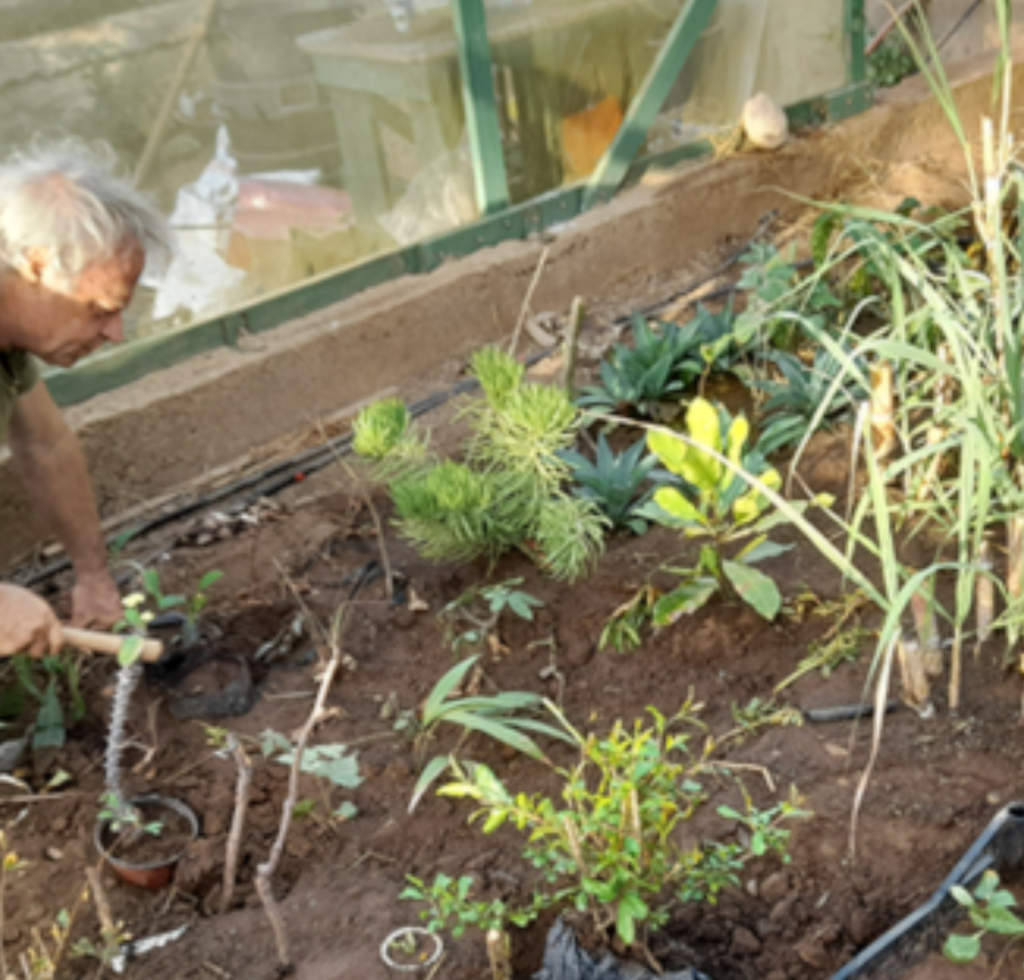
My proposal is to revitalise this cooperative, but also to create mini nurseries through micro-credits. I’d like to make it clear that the choice of Monte Vermelho as the location was consistent with the village of Calheta, and close to other agricultural crops. My concern is not to be in a “ghetto” for westerners, but with “the people of the land”. Food self-sufficiency on the island of Maio is no empty word. The lack of water minimises the crops and year after year, the situation is more and more catastrophic due to the climatic conditions. By setting up this regenerative agroforestry system, we want to prove that there are solutions for moving towards food self-sufficiency. By creating this pilot Oasis, we can find the keys to developing local agriculture that respects the environment. The purpose of this site will be educational, so that other projects can flourish. Let’s not forget the adage: “Control Food and you control People”.

